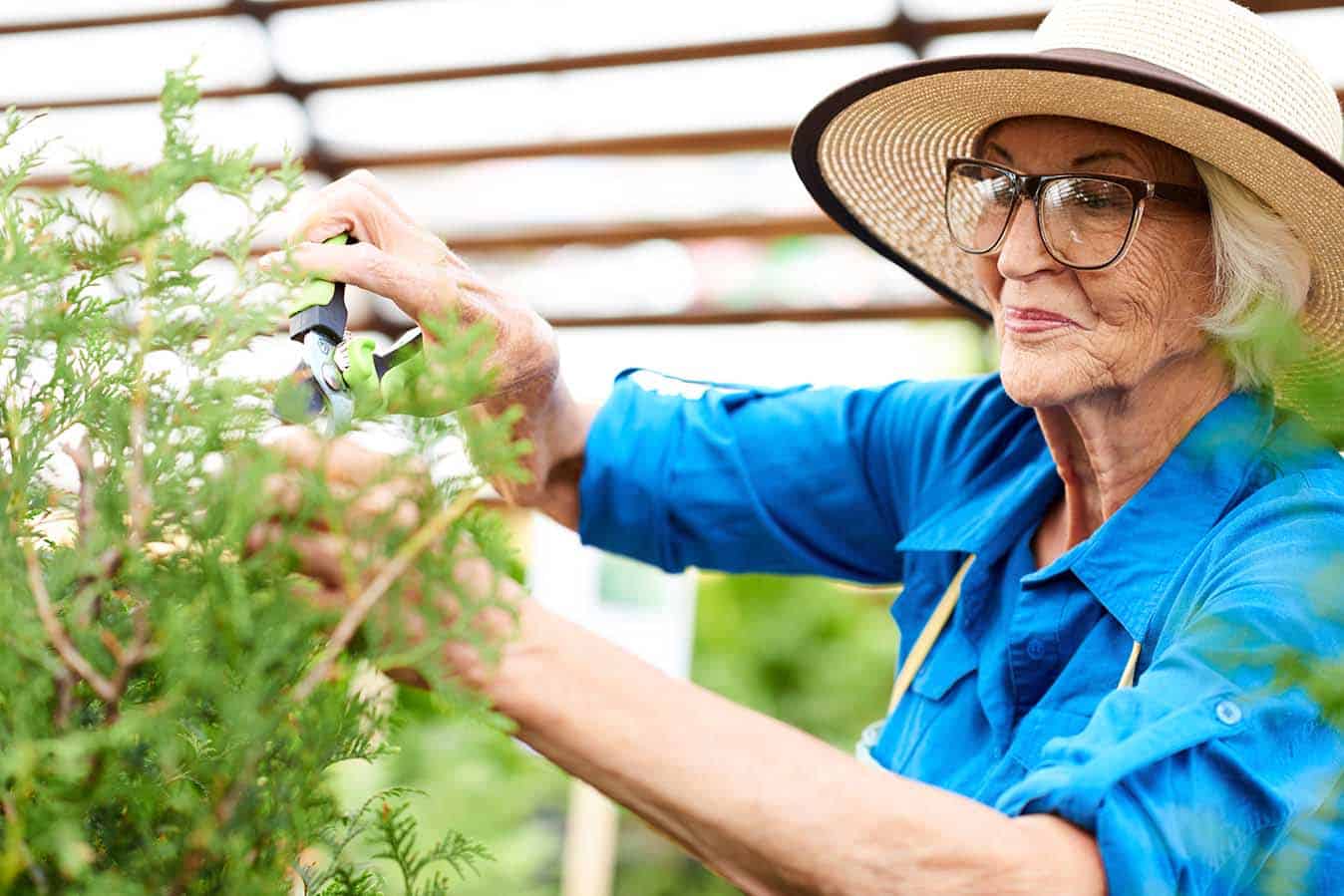During my first clinical placement, an awe feeling struck me as I walked to the dining lounge overlooking a beautiful vegetable and flower garden. This was my first ever experience of being in an aged care facility that to my disbelief, some of the frail residents were actively enjoying gardening and checking their potted seedlings.
Certainly, gardens are important places or spaces where human and the land come together in the most inspiring way (Bradley, et al., 2009) but my naïve notion of gardening and growing plants as only for those strong and able-bodied was for me perplexing.
An important realisation sunk in for me: gardening activity by old and frail people who mostly are suffering from illness or functional disabilities is obviously more than growing food, creating a beautiful flower garden or fun.
Thought bubbles formed and I asked myself ‘what health benefits do gardens and gardening provide older people?
Answering this question would help me and possibly other emerging nurses to understand the therapeutic effects of gardens and gardening activities to older people. Such understanding within the context of nursing practice can harness the value of such spaces in home care settings, aged care and clinical facilities (Uwajeh, et al., 2019). While horticulture therapy has been used as a catch-all-phrase, different albeit related terms are being used and often confusing (American Horticulture Therapy Association, 2012).
These terms are herein defined to distinguish their essential differences. Horticulture therapy employs plants and gardening activities to achieve specific therapeutic or rehabilitative goals to maximise social, cognitive, physical and/or psychological functioning which have been developed and used in clinical setting (Detweiler, et al., 2012). Therapeutic horticulture is a process that uses plants and plant-related activities through which participants strive to improve their wellbeing through active or passive involvement (American Horticulture Therapy Association, 2012). Horticulture therapy and therapeutic horticulture are classified as program types. These program types may use a particular or a combination of garden kinds. Healing gardens are environments dominated by plants such green plants, flowers, water, and other aspects of nature and are generally associated with healthcare facilities designed to be accessible to all to have beneficial effects on most users (American Horticulture Therapy Association, 2012).
A therapeutic garden are designed as a component of a treatment program such as occupational therapy, physical therapy, or horticultural therapy programs and can be considered as a subcategory of a healing garden (American Horticulture Therapy Association, 2012).
Following these definitions, searches were conducted in PubMed, Cochrane, Web of Science and Google Scholar using keywords – horticulture therapy; therapeutic horticulture, therapeutic garden, and healing garden. Search results were then filtered using the following keywords: elderly, older people, and frail and limiting searches for materials published since 2015.
The psychosocial, physical, physiological and cognitive effects of gardens and gardening activities in structured horticulture therapy programs were investigated as reported below.
Effects of Gardens and Gardening for Elderly
The therapeutic effects of gardens and gardening are well documented and appreciated throughout the history of civilisation (Winterbottom & Wagenfeld, 2015; Souter-Brown, 2015).
This has intensified over recent decades due to the significant population growth in cities worldwide (Souter-Brown, 2015). Gardening is also a key leisure activity of older adults in Australia (Patterson & Chang , 1999; Scott, et al., 2015; Scott, et al., 2020). With the ever growing population of older adults (>60 years old) globally (World Health Organization, 2021) and in Australia (Australian Institute for Health and Wellbeing, 2020) the need to better understand ways to promote wellness amongst the older population is inevitable (Wang & MacMillan, 2013). In a seminal work in Therapeutic Horticulture, Houseman (1986) argued that older adults enjoyed working with plants for which horticulture therapy activities can bring a wide spectrum of benefits to older people. Benefits of gardening, in particular horticulture therapy, can be classified into psychosocial, physical and functional, physiological and cognitive (Nicholas, et al., 2019).
Psychosocial benefits
A common direct effect of horticulture therapy is improvement on quality of life and wellbeing. In a study conducted by Lo et al., (2019), 22 frail and/or pre-frail nursing home residents aged over 70 years in Hong Kong were interviewed in relation to horticultural therapy.
The study found that horticulture therapy is an enjoyable activity or past time and growing and tending plants made the participants happy. While this is a qualitative study which providing the voice of older people living in nursing home, caution should be made in making direct comparison with groups of people from different cultural background, ie. non-Southeast Asian.
A Swedish research study, Dahlkist et al., (2016) interviewed 290 residents in aged care facilities in central and northern Sweden that examined the relationship between greenery in gardens at residential facilities for older people and self-perceived health benefits of gardens.
This study found a positive and significant effect of gardens on the perceived health of residents and concluded that gardens affect the health of residents by enhancing sense of being away afforded by an experience of the outdoor environment. The authors noted that residents’ perceived effect of the garden is dependent upon barriers which they must overcome to visit or see the garden. Understanding these barriers will be important in making generalisations from the results of this study.
Other psychosocial benefits of horticulture therapy reported from the systematic review by Nicholas, et al. (2019) includes decrease in anxiety and depression, decrease in agitation, improvement in mood and engagement particularly in adults with Dementia, improvement in social relations, and decrease in loneliness.
Physical and functional benefits
A study by Scott et al., (2015) examined the perceived therapeutic benefits of leisure gardening for older Australian adult gardeners residing in community using quantitative and qualitative data from a survey of 331 older adults in Australia. Results of the study showed that physical activity and exercise being the top most important beneficial aspect of gardening.
The concepts revealed included physical, active, health, ability, control and rejuvenation. In a similar study, Chalmin-Pui et al., (2021) explored why people in the UK engaged with gardening and the extent to which any health and wellbeing benefits were acknowledged by gardeners through an electronic survey of 5,766 gardeners and 249 non-gardeners.
Their study found significant associations between improvements in wellbeing, perceived stress and health benefits and more frequent gardening with at least two to three times per week of gardening activity providing greatest health benefits. These studies supported the important health benefits of home gardening and its potential as a health intervention to improve physical functions of elderly.
A quasi-experimental study conducted in Taiwan with 85 (41 experimental group and 44 control group) older adults aged 65 years old and above by Yao and Chen, (2017) tested the effects of horticulture therapy on activities of daily living, happiness, meaning of life, and interpersonal intimacy of older adults in a nursing home. The experimental group were involved in a horticulture therapy program where they grew small plant in a pot indoor in eight sessions. The Barthel index was used to measure daily living function. Happiness was measured using the Chinese happiness index, The meaning of life was measured using the Crumbaugh and Maholick meaning of life scale, while interpersonal intimacy was measured using interpersonal intimacy scale.
Results showed that activities of daily living had improved and were better in the experimental group than the control group. The experimental group became more active during the horticulture therapy session than they were previously. The researchers noted that participants in wheelchairs wheeled themselves to activity sites and nursing home staff reported that participants became more proactive in completing activities of daily living tasks, such as eating meals.
Due to limited mobility of nursing home residents and limited space for gardening indoors, gardening using a garden was not possible. Another weakness of the study is the short eight weeks period of observations, which may not correspond to the life cycle of most plant species grown indoors. Additionally, the participants were not assigned randomly to the experimental groups, thus sampling errors are possible.
Physiological benefits
Gardening has also shown significant effects on the physiological indicators among elderly (Nicholas, et al., 2019). Tu, et al., (2020) assessed the physiological variables – heart rate variability (HRV) via electrocardiograph (ECG), pulse rate, blood pressure, and salivary amylase activity (SAA) before and after four horticultural activities of 27 elderly aged 60 to 76 years, in a senior citizens learning camp in Taiwan.
Results found that a downward trend in low frequency/high frequency HRV, pulse rate and SAA after horticultural activities and upward trend in SDNN and slight increase of blood pressure. Except for an increase in blood pressure, the study showed that horticulture activities resulted in the elderly being relaxed. A randomised controlled trial was conducted in South Korea by Han, et al., (2018) to determine the effects of a plant cultivation-based horticulture therapy program for elderly with mental health problems. Twenty-eight participants were randomly assigned to control group (n=14) and horticulture therapy group (n=14). The horticulture therapy program which lasted for three months includes making plant beds, planting and transplanting, watering, weeding and harvesting and conducted in a farm in South Korea. Saliva samples for cortisol measurement were collective noninvasively before start of the program and weekly after finishing the weekly horticulture activity. Results showed cortisol level decreased by about half from 7.56 before to 3.80 after the program in horticulture therapy group while no significant change in cortisol level in the control group. This indicated that horticulture therapy reduces stress in elderly.
Cognitive benefits
There is an increasing body of evidence that gardening and garden visits improve cognition in older adults. A study in Illinois, USA, Liao et al., (2020) surveyed 42 staff of nine dementia care facilities using semi-structured questionnaire to evaluate the effects of the garden on mood, social interaction, cognition and behavioural problems and determine behavioural problems and cognitive abilities that may improve after visiting a garden. The study found a visit to garden had positive impacts on client’s cognition. In particular, majority of staff who participated in the study reported significant improvement in attention and orientation to time. This study provided strong evidence from staff working with clients with dementia on the impact of garden visits improving cognitive abilities.
A randomised controlled trial on the effects of gardens on cognition was conducted by Pedrinolla et al., (2019) in Italy examined the effect of indoor therapeutic garden (ITG) on neuropsychiatric inventory (NPI) and mini-mental scale examination (MSSE) of 163 clients randomly assigned to either ITG group or control group. The study found a significant reduction in NPI from 67.7 down to 38.7 in ITG group compared slight increase from 66.4 to 70.0 in control group. An increase in MSSE from 13.2 to 14.0 in the ITG group while a slight decline of MSSE from 13.1 to 12.2 in the control group. These results showed that ITG improved cognition and behavioural and psychological symptoms of dementia providing strong evidence on the use of gardens as promising non-pharmacological treatment to Alzheimer’s disease.
Summary and reflections
Gardening is an important recreational activity of older Australians due to various health benefits (Scott, et al., 2020; Scott, et al., 2015). The selected literature reviewed in the previous section outlined the key benefits of garden and gardening on health and wellbeing of older people. Gardening and gardens provide psychosocial, physical, physiological and cognitive benefits necessary for healthy ageing. Studies reviewed above showed that gardening can create a relaxing mood to gardeners resulting in lower blood pressure, pulse rate and salivary amylase activity and significant reduction in cortisol levels. Such result is corroborated by qualitative studies where residents in nursing homes involve in horticulture therapy and garden visit reported feeling happy and improvement in quality of life after engaging in garden visit and horticulture therapy programs. Physical functionality was also reported to improve due to more physical activities and exercise through garden activities. There is a strong evidence on the effects of gardening in improving cognition in older adults particularly those with dementia, ie. improving attention and orientation to time. This is explained partly with the calming effect of plants and space and changes in physiological processes when exposed to garden or when engaged in gardening.
The literature search showed an overwhelming evidence about the effects of gardening and horticulture therapy particularly as part of trials in treating mental health problems and dementia clients. However, studies about the effects on older adults in age care facilities and homes particularly in the last five years is less represented and most available literature were outside Australia. Results of these studies are however generalisable into the Australian context. While there are several books on healing garden designs, the literature search showed that studies in Australia about the use of garden spaces in age care facilities on the management of wellbeing and quality of life of aged care residents is scanty. It seems that use of gardens and garden spaces in Australian aged care facilities and homes of older adults are less valued and not optimised in delivering an integrative health and wellbeing programs.
References
American Horticulture Therapy Association, 2012. [Online] Available at: https://web.archive.org/web/20130908221648/http://ahta.org/sites/default/files/DefinitionsandPositions.pdf [ Accessed 10 November 2021].
Australian Institute for Health and Wellbeing, 2020. Health of older adults. [Online] Available at: https://www.aihw.gov.au/reports/australias-health/health-of-older-people
[Accessed 20 October 2021].
Bradley, F. M., Ellis, B. W. & Phillips, E., 2009. Rodale’s ultimate encyclopedia of prganic gardening: the indespensible green resource for every gardener. Emmaus Pa: Rodale Press.
Chalmin-Pui, L. S., Griffiths, A., Roe, J. & Heaton, T., 2021. Why garden? attitudes and the perceived health beefits of home gardening. Cities, Volume 112.
Dahlkvist, E. et al., 2016. Garden greenery and the health of older people in residential care facilities: a multi-lelve cross sectional study. Journal of Advance Nursing, 72(9), pp. 2965-2076.
Detweiler, M. et al., 2012. What is the evidence to support the use of therapeutic garndes for the elderly?. Psychiatry Investigation, 9(2), pp. 100-110.
Han, A.-R., Park, S.-A. & Ahn, B.-E., 2018. Reduced stress and improved physical functiinal ability in elderly with mental health problems following horticulture therapy program. Complementary Therapies in Medicine, pp. 19-23.
Houseman, D., 1986. Developing links between horticulture therapy and aging. Journal of Therapeutic Horticulture, 1(1), pp. 9-14.
Liao, M.-L.et al., 2020. Effects of garden visit on people with demential: a pilot study. Dementia, 19(4), pp. 1009-1028.
Lo, S. et al., 2019. Effects of horticultural therapy: perspective of frail and pre-frail older nursing home residents. Nursing Open, Volume 6, pp. 1230-1236.
Nicholas, S., Giang, A. & Yap, P., 2019. The effectiveness of horticultural therapy on older adults: a systematic review. Journala and Post-Acute and Long Term Medicine, Volume 20, pp. 131.e1-1351.e11.
Patterson, I. & Chang , M., 1999. Participation in physical activities by older adults Australian: a review of the social psychological benefits and cosntraints. Australasian Jorunal on Ageing, 18(4), pp. 79-84.
Pedrinolla, A. et al., 2019. An indoor therapeutic garden for behavioral symptoms in Alzheimer’s Disease: a randomized controlled trial. Journal of Alzheimer’s Disease, Volume 71, pp. 813-823.
Scott, T., Basser, B. & Pachana, N., 2020. Positive aging benefits of home and community gardening activities: older adults report enhance self-steem, productive endeavours, social engagement and exercise. SAGE Open Medicine, Volume 8, pp. 1-13.
Scott, T., Masser, B. & Panchana, N., 2015. Exploring the health and well-being of benefits of gardening for older adults. Ageing and Society, Volume 35, pp. 2176-2200.
Souter-Brown, G., 2015. Landscape and urban design for health and well-being: using healing, sensory and therapeutic gardens. Oxon: Routledge.
Tu, P.-C., Cheng, W.-C. & Chang, Y.-S., 2020. Effects of types of horticultural activity on the physical and mental state of elderly individuals. International Journal of Environmental Research and Public Health, Volume 17, pp. 1-13.
Uwajeh, P., Iyendo , T. & Polay, M., 2019. Therapeutic gardens as a design approach for optimising the healing environment of patients with Alzheimer’s disease and other dementias: a narrative review. Explore, Volume 15, pp. 352-362.
Wang, D. & MacMillan, T., 2013. The benfits of gardening for older adults: a systematic revie wof the literature. Activities, Adaptation and Aging, 37(2), pp. 153-181.
Winterbottom, D. & Wagenfeld, A., 2015. Therapeutic Gardens: Design for healing spaces. London: Timber Press Inc.
World Health Organization, 2021. Ageing and health. [Online] Available at: https://www.who.int/news-room/fact-sheets/detail/ageing-and-health
[Accessed 20 October 2021].
Yao, Y.-F. & Chen, K.-M., 2017. Effects of hortiuclutre therapy on nursing homes older adults in Southern Taiwan. Quality of Life Research, Volume 26, pp. 1007-1014.
Author:
Edwin Cedamon is currently trying to shift his career from a Forest Scientist where he has post-graduate qualification (PhD in Forestry) to Nursing. Edwin is on his last stage of studies for Diploma of Enrolled Nursing at TAFE South Australia Barossa Valley Campus.








